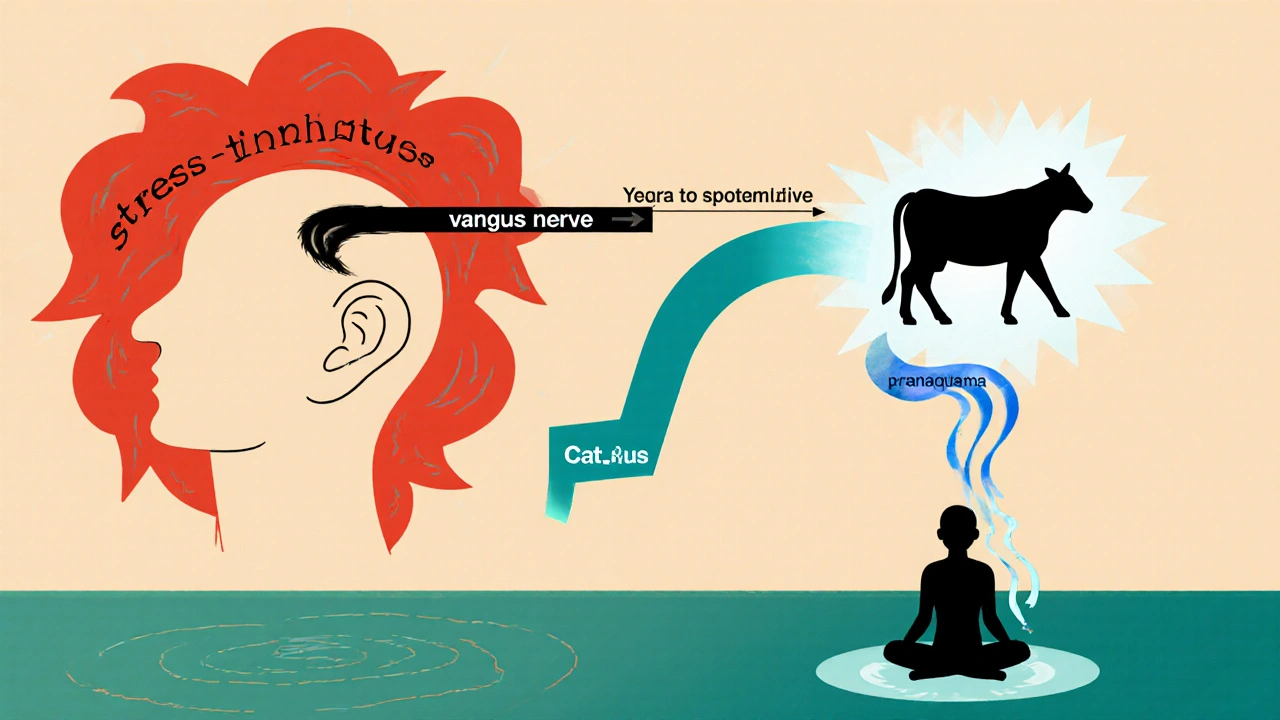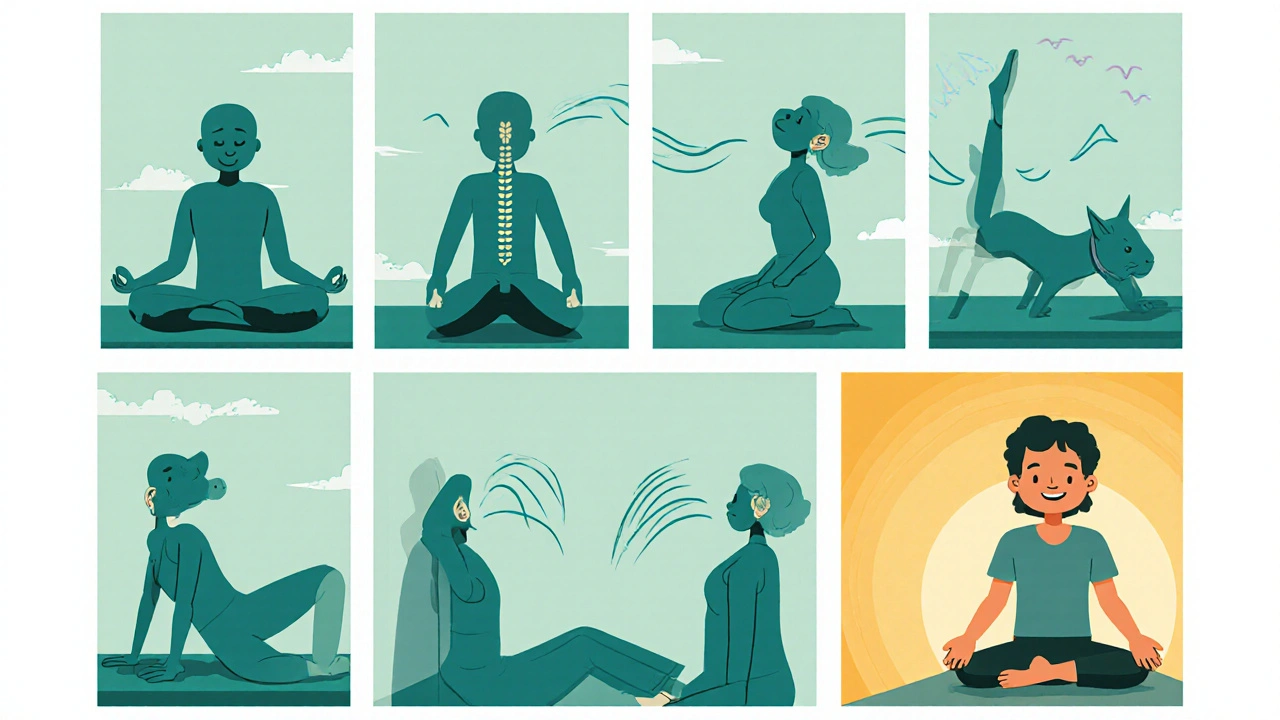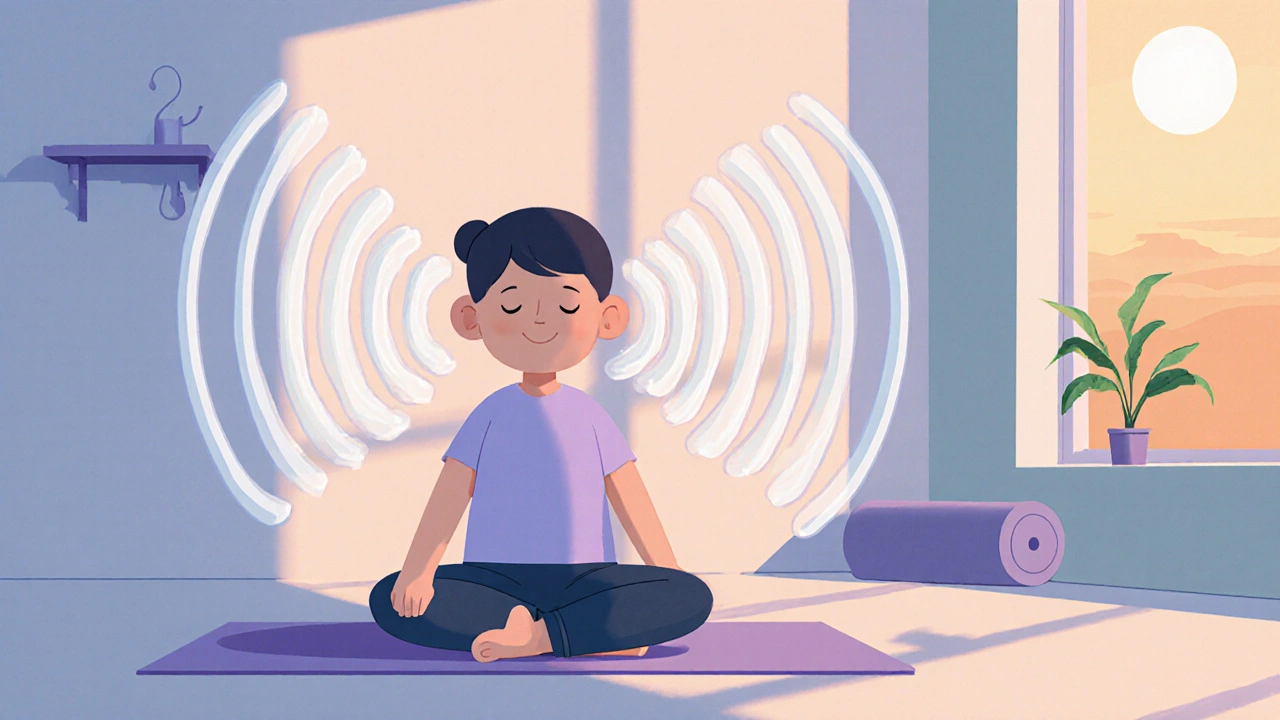When it comes to ear ringing, Yoga is a mind‑body practice that blends physical postures, breath control, and meditation. Yoga for tinnitus has been popping up in forums and health blogs, but does it really move the needle on that persistent buzz?
Tinnitus is the perception of sound-usually a ringing, buzzing, or hissing-without an external source. It affects about one in ten adults at some point, and for roughly 2% the noise is severe enough to interfere with sleep, work, or relationships. The cause can be anything from age‑related hearing loss to prolonged exposure to loud music, but stress and the nervous system play a surprisingly big role.
Why Stress Makes Tinnitus Worse
When you’re stressed, your body releases cortisol and adrenaline. Those hormones tighten blood vessels and crank up the activity of the autonomic nervous system. In the ear, tighter vessels can change the fluid balance of the cochlea, making the phantom sounds louder. The vagus nerve-your body’s main parasympathetic conduit-also influences auditory processing. Heightened sympathetic tone (the "fight‑or‑flight" side) can amplify the brain’s perception of internal noise.
How Yoga Targets Those Underlying Triggers
Yoga attacks the stress‑tinnitus loop on three fronts:
- Breath work (pranayama) slows the breath, which directly lowers cortisol and pulls the nervous system toward a relaxed state.
- Gentle movement improves blood circulation to the inner ear, helping the cochlear fluid stay balanced.
- Meditation and mindfulness train the brain to ignore irrelevant sounds, a technique known as sound habituation.
In short, regular practice can dial down the physiological stress that makes tinnitus flare up.
What the Science Says
Research on yoga and tinnitus is still emerging, but a handful of studies give us clues:
- A 2022 pilot trial published in the Journal of Otolaryngology enrolled 30 participants with chronic tinnitus. After eight weeks of a 30‑minute yoga routine, 70% reported a noticeable drop in loudness scores (measured on a 0‑10 scale).
- The American Tinnitus Association cites a 2020 survey where 58% of respondents who practiced yoga said the activity helped them manage stress‑related tinnitus spikes.
- Harvard Medical School’s 2021 review of mind‑body interventions highlighted yoga’s ability to modulate the vagus nerve, a pathway directly linked to auditory perception.
While large‑scale randomized trials are still needed, the early data line up with what practitioners observe on the mat.

Yoga Poses That May Soothe Ringing
Not every pose is created equal for ear health. The following postures focus on neck relaxation, gentle inversion, and deep breathing-key ingredients for tinnitus relief.
- Cat‑Cow (Marjaryasana‑Bitilasana): Moves the cervical spine, releases neck tension, and promotes fluid flow.
- Child’s Pose (Balasana): Lowers heart rate, encourages diaphragmatic breathing, and relaxes the jaw.
- Legs‑Up‑the‑Wall (Viparita Karani): A mild inversion that improves venous return from the head, reducing ear pressure.
- Seated Forward Bend (Paschimottanasana): Stretches the back of the neck and calms the nervous system.
- Fish Pose (Matsyasana): Opens the throat and chest, aiding breath depth and vagal tone.
- Neck Release (Gentle Side‑to‑Side Stretch): Directly eases muscular tightness that can compress auditory nerves.
A Sample 15‑Minute Routine
Set aside a quiet space, use a yoga mat or soft carpet, and follow this flow. Each movement is synced with a calm breath count (inhale for 4, exhale for 6).
- Start in a comfortable seated position. Close the eyes and take three deep diaphragmatic breaths.
- Move into Cat‑Cow for 2 minutes, matching each arch and round with the breath.
- Transition to Child’s Pose. Stay for 3 minutes, focusing on the rise and fall of the belly.
- Slide a bolster or folded towel under the shoulders and roll back into Legs‑Up‑the‑Wall for 4 minutes. Keep the shoulders relaxed.
- Sit up, extend the legs, and fold forward into Paschimottanasana for 2 minutes. Let the head gently rest on the shins.
- Finish with Fish Pose, supporting the upper back on a pillow, and stay for 2 minutes, breathing through the nose.
- End with a 30‑second seated meditation, noticing any change in the ringing.
The routine is low‑impact, so it’s safe for most ages. If you have high blood pressure or glaucoma, skip the inversion (Legs‑Up‑the‑Wall) or modify with a pillow under the hips.

Tips, Precautions, and When to Seek Professional Help
- Consistency beats intensity. A short daily practice often works better than a long, occasional session.
- Listen to your body. If a pose feels uncomfortable in the neck or jaw, ease out or substitute a gentler stretch.
- Combine yoga with other tinnitus‑friendly habits: low‑salt diet, regular hearing checks, and sound therapy apps.
- Never replace medical evaluation with yoga alone. If the ringing is sudden, accompanied by dizziness or hearing loss, see an audiologist right away.
Quick Reference Table
| Style | Intensity | Focus for Tinnitus | Best For |
|---|---|---|---|
| Hatha Yoga | Low‑to‑moderate | Breath awareness, gentle stretches | Beginners, those with limited mobility |
| Restorative Yoga | Very low | Deep relaxation, vagus‑nerve activation | People seeking stress reduction |
| Yin Yoga | Low | Long holds for connective‑tissue release | Those who like meditative stillness |
| Kundalini Yoga | Moderate | Pranayama and chanting to calm the mind | Practitioners comfortable with breath work |
Bottom Line
Yoga isn’t a miracle cure, but it can chip away at the stress, circulation, and nervous‑system factors that amplify tinnitus. By adding a short, consistent practice to your routine, many people notice a softer, less intrusive ringing. Pair it with regular hearing‑health check‑ups and you’ve got a well‑rounded approach.
Can yoga completely cure tinnitus?
Most experts agree that yoga alone won’t erase the sound forever. It can, however, reduce how loudly you perceive it and make stress‑related spikes less frequent.
How often should I practice yoga for tinnitus?
Aim for 10‑15 minutes a day. Consistency is key; the nervous system adapts better to regular signals.
Are inversions safe for ear ringing?
Mild inversions like Legs‑Up‑the‑Wall are usually fine and can improve head circulation. Skip deep head‑stands if you have high blood pressure, glaucoma, or neck injuries.
Do I need special equipment?
A yoga mat, a bolster or pillow, and a strap for neck stretches are enough. Many poses work just as well on a carpet.
Should I combine yoga with other tinnitus treatments?
Yes. Sound therapy, dietary tweaks, and regular audiology check‑ups complement yoga’s stress‑reduction benefits and give the best chance at relief.



People who tout yoga as a panacea for tinnitus often overlook the fundamental principle that any therapeutic claim demands rigorous scientific validation, yet they parade anecdotal successes as if they were conclusive evidence. The stress‑induced cascade described in the article is sound, but attributing measurable reductions in auditory phantom noise solely to a few minutes of stretching is a simplification that borders on mysticism. In a world where we have access to controlled trials and peer‑reviewed data, it is irresponsible to suggest that a practice rooted in ancient philosophy can replace evidence‑based audiological interventions. Moreover, the notion that gentle inversions can directly modulate cochlear fluid dynamics fails to account for the complex homeostatic mechanisms governing inner‑ear pressure, which are not easily swayed by posture alone. While the breath work components may indeed lower systemic cortisol, the magnitude of that effect varies dramatically between individuals and is influenced by baseline fitness, mental health status, and even genetic predisposition. It would be more accurate to present yoga as a complementary stress‑management tool rather than a direct cure for ringing ears. The pilot study cited, with only thirty participants, lacks the statistical power to generalize findings across the diverse tinnitus population, which includes sufferers with differing etiologies such as ototoxic drug exposure, acoustic trauma, and age‑related degeneration. A 70% self‑reported improvement does not equate to a clinically significant change when measured against standardized psychoacoustic scales, and self‑reporting is notoriously susceptible to placebo effects. The American Tinnitus Association’s survey, while informative, suffers from selection bias because respondents are already inclined toward holistic remedies. Harvard’s review on mind‑body interventions highlights vagal modulation, yet it cautions that the evidence remains preliminary and cannot be extrapolated to assert definitive therapeutic outcomes.
I appreciate the thoroughness of the analysis, yet it’s worth noting that many patients seek relief through any safe avenue, and yoga’s low‑risk profile makes it a reasonable adjunct therapy when used responsibly.
Breathing deep into the diaphragm can calm the nervous system and reduce perceived ringing. Consistent practice helps the brain filter out internal noises. No need for fancy equipment just a mat and a few minutes each day.
Honestly the drama of claiming yoga cures tinnitus is overblown; a concise routine can aid relaxation but it’s not a miracle.
From my experience as someone who’s tried both sound therapy and gentle yoga, I can say that incorporating a short daily session-especially poses that release neck tension-does seem to lower the intensity of the ringing during stressful periods. It’s not a replacement for medical evaluation, but it acts like a supportive cushion alongside conventional treatments. Always listen to your body and avoid any pose that causes discomfort in the jaw or neck.
Yoga adds a calming layer to tinnitus management; keep sessions short and consistent.
Yoga won’t magically silence the tinnitus.